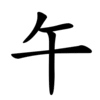午
| ||||||||
Translingual
| Stroke order | |||
|---|---|---|---|
| Stroke order | |||
|---|---|---|---|
 | |||
Han character
午 (radical 24, 十+2, 4 strokes, cangjie input 人十 (OJ) or X人十 (XOJ), four-corner 80400, composition ⿱𠂉十 or ⿰丿干)
References
- KangXi: page 156, character 4
- Dai Kanwa Jiten: character 2703
- Dae Jaweon: page 354, character 1
- Hanyu Da Zidian: volume 1, page 406, character 1
- Unihan data for U+5348
Chinese
| simp. and trad. |
午 | |
|---|---|---|
Glyph origin
| Historical forms of the character 午 | |||
|---|---|---|---|
| Shang | Western Zhou | Shuowen Jiezi (compiled in Han) | Liushutong (compiled in Ming) |
| Oracle bone script | Bronze inscriptions | Small seal script | Transcribed ancient scripts |
 |
 |
 |
 |
| Characters in the same phonetic series (午) (Zhengzhang, 2003) | |
|---|---|
| Old Chinese | |
| 卸 | *sŋjaːs |
| 汻 | *hŋaːŋʔ |
| 滸 | *hŋaːʔ |
| 午 | *ŋaːʔ |
| 仵 | *ŋaːʔ |
| 旿 | *ŋaːʔ |
| 忤 | *ŋaːs |
| 迕 | *ŋaːs |
| 杵 | *ŋ̊ʰjaʔ |
| 籞 | *ŋaʔ |
| 蘌 | *ŋaʔ |
| 篽 | *ŋaʔ |
| 禦 | *ŋaʔ, *ŋas |
| 許 | *hŋaʔ |
| 御 | *ŋas |
Etymology 1
Norman (1985) proposed connection with Austroasiatic; Ferlus (2013) noted a "[g]ood correspondence" between Proto-Vietic *m-ŋəːʔ (whence Vietnamese ngựa) and Old Chinese reconstructions like *m-qʰˁaʔ (Baxter-Sagart) and *ᵀs.ŋaʔ (Ferlus).
Alternatively, Smith (2011) proposed 午 (OC ŋaaʔ)'s cognacy with 啎 (OC *ŋaas) "to meet head on" and 御 (OC *ŋraas) "to meet in (battle)" and suggested that "the moon at its full phase opposes the sun directly in the sky, meaning *ŋaaʔ 午 is probably to be glossed, given *-ʔ , ‘facing stage’". Schuessler (2007) regarded 午 (OC ŋâh) "to go against" as a mere graphic variant of 啎 and thus deemed the sense "to go against" distinct from the "earthly branch" sense.
Pronunciation
Definitions
午
Compounds
Etymology 2
| For pronunciation and definitions of 午 – see 舞 (“dance; to dance; etc.”). (This character, 午, is the second-round simplified form of 舞.) |
Notes:
|